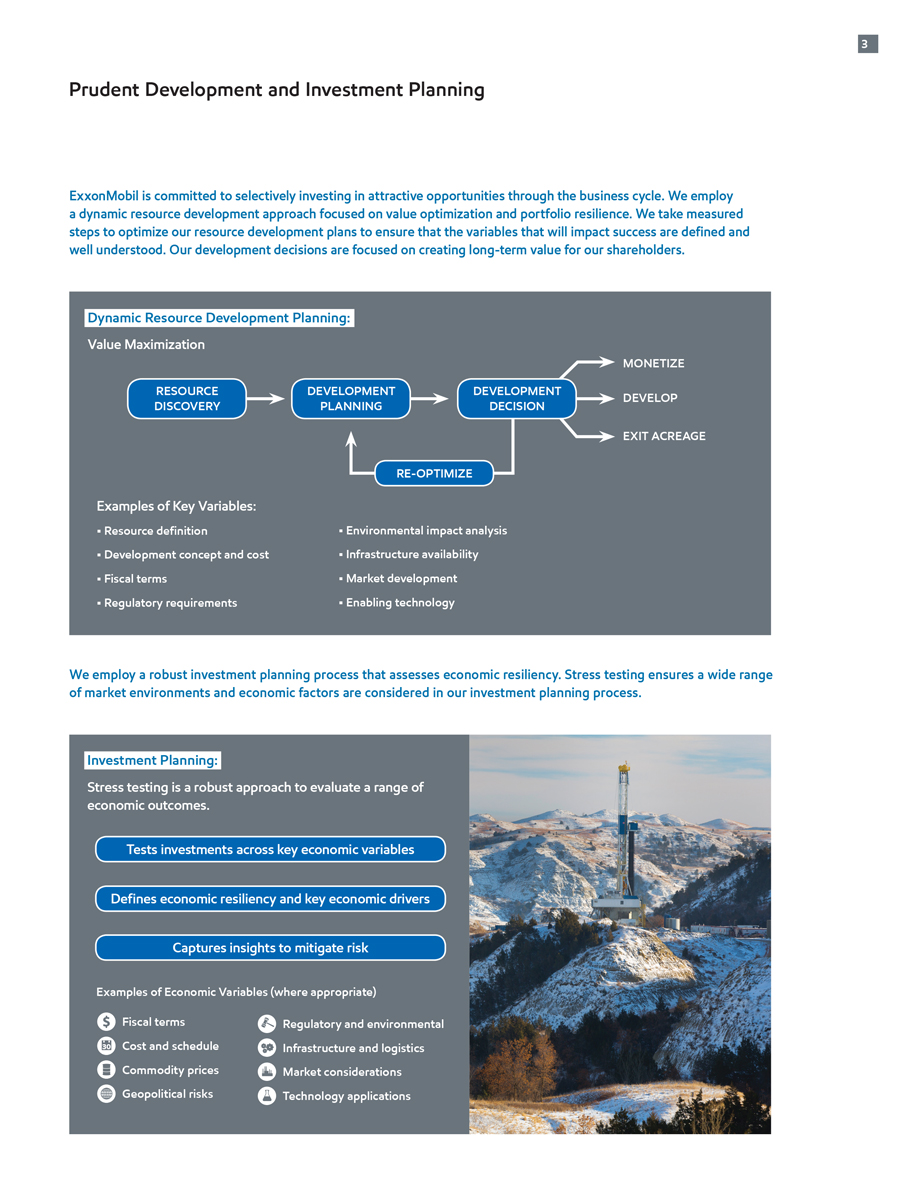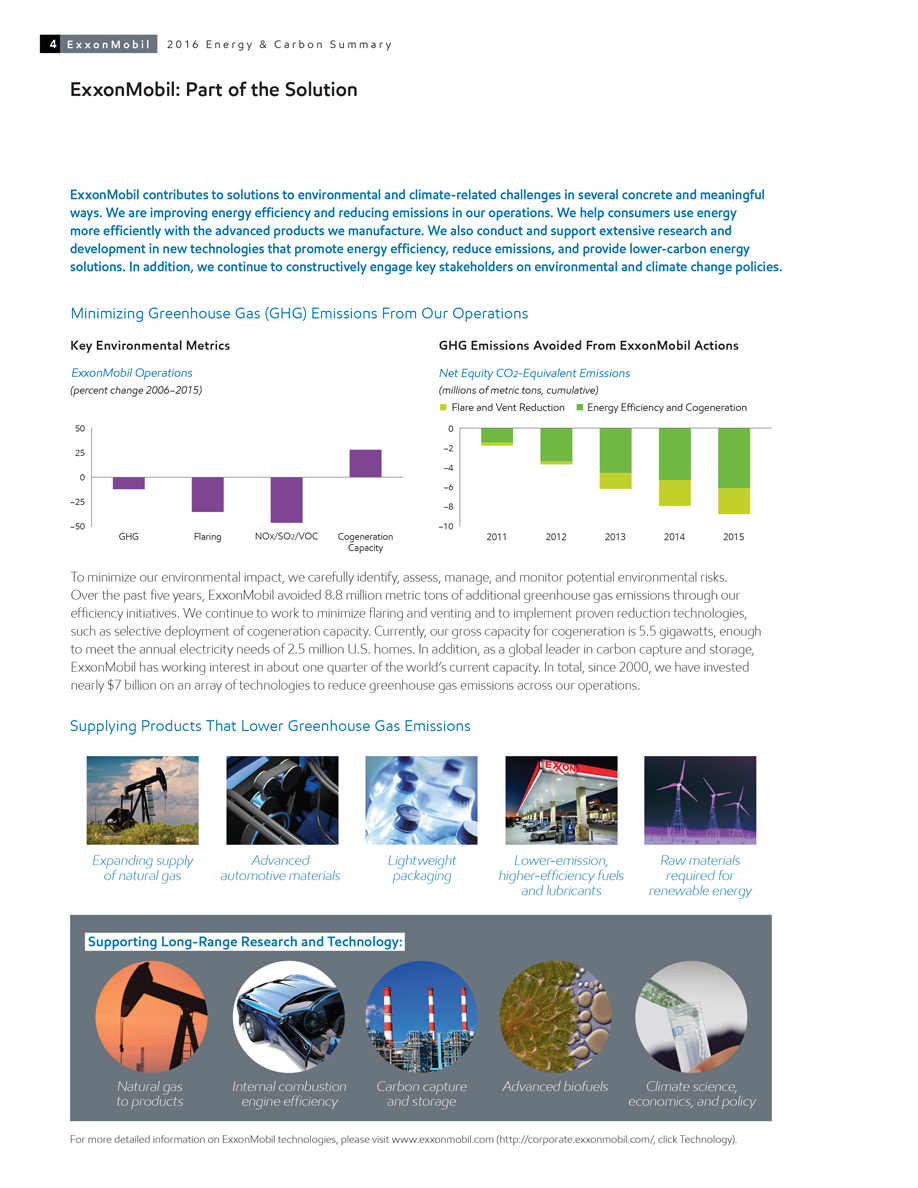UNITED STATES
SECURITIES AND EXCHANGE COMMISSION
Washington, D.C. 20549
SCHEDULE 14A
Proxy Statement Pursuant to Section 14(a)
of the Securities Exchange Act of 1934
(Amendment No. )
Filed by the Registrant ☒
Filed by a Party other than the Registrant ☐
Check the appropriate box:
| ☐ Preliminary Proxy Statement |
☐ Confidential, for Use of the Commission Only(as permitted by Rule 14a-6(e)(2)) | |
|
☐ Definitive Proxy Statement |
||
| ☒ Definitive Additional Materials | ||
| ☐ Soliciting Material Pursuant to §240.14a-12 | ||
EXXON MOBIL CORPORATION
(Name of Registrant as Specified In Its Charter)
(Name of Person(s) Filing Proxy Statement, if other than the Registrant)
Payment of Filing Fee (Check the appropriate box):
| ☒ | No fee required. |
| ☐ | Fee computed on table below per Exchange Act Rules 14a-6(i)(4) and 0-11. |
| (1) | Title of each class of securities to which transaction applies: |
| (2) | Aggregate number of securities to which transaction applies: |
| (3) | Per unit price or other underlying value of transaction computed pursuant to Exchange Act Rule 0-11 (set forth the amount on which the filing fee is calculated and state how it was determined): |
| (4) | Proposed maximum aggregate value of transaction: |
| (5) | Total fee paid: |
| ☐ | Fee paid previously with preliminary materials. |
| ☐ | Check box if any part of the fee is offset as provided by Exchange Act Rule 0-11(a)(2) and identify the filing for which the offsetting fee was paid previously. Identify the previous filing by registration statement number, or the Form or Schedule and the date of its filing. |
| (1) | Amount Previously Paid: |
| (2) | Form, Schedule or Registration Statement No.: |
| (3) | Filing Party: |
| (4) | Date Filed: |

2016 Energy & Carbon Summary

Society continues to face the dual challenge of meeting energy demand to support the economic growth needed for improved living standards, while simultaneously addressing the environmental risks posed by rising greenhouse gas emissions and climate change. This dual challenge addresses two of the United Nations’ Sustainable Development Goals: affordable and clean energy (#7) and climate action (#13). ExxonMobil’s Position on Climate Change ExxonMobil believes that the risks of climate change are serious and warrant thoughtful action. That is why we are working to be part of the solution. Reducing Greenhouse Gas Emissions in Our Operations Since 2000, we have spent nearly $7 billion on technology solutions to reduce emissions. This includes investments of more than $3.8 billion to improve energy efficiency and flare mitigation at our Upstream facilities around the world. Additionally, we have invested more than $2 billion in cogeneration facilities to more efficiently produce electricity and reduce greenhouse gas emissions at our manufacturing sites. Helping Consumers Reduce Emissions We are delivering solutions that enable our customers to reduce their own emissions and improve their own energy efficiency by increasing the reliability, performance, and longevity of their products. One of the greatest opportunities for society to reduce greenhouse gases is through the use of natural gas in power generation. Natural gas is a versatile, abundant, and low-emission fuel that is widely available around the globe. In power generation, natural gas emits up to 60-percent fewer greenhouse gas emissions than coal. In addition to supplying natural gas around the world, ExxonMobil also produces fuels and lubricants that deliver higher vehicle efficiency and lower emissions. We continue to work on research and development of new fuels, lubricants, and chemical products that deliver higher efficiency, lighter-weight packaging, and lower emissions. Supporting Research That Leads to Technological Breakthroughs As society transitions to lower carbon intensity energy solutions, technological advancements that change the way we produce and use energy will be instrumental in providing the global economy with the energy it needs without increasing greenhouse gas emissions. We are conducting fundamental research to develop energy solutions that lower carbon intensity and have the potential to be economically feasible without subsidies or mandates. ExxonMobil is pioneering scientific research to discover innovative approaches to enhance existing supply options and develop next-generation energy sources, such as algae biofuels. Participating in Constructive Dialogue on Policy Options ExxonMobil believes the long-term objective of effective policy is to reduce the risks posed by climate change at minimum societal cost, in balance with other societal priorities to boost living standards, such as poverty eradication, education, health, security, and energy affordability. We fundamentally believe that free markets, innovation, and technology are essential to addressing the risks of climate change. Policies need to be clear, effective, and guard against duplicative, overlapping, and conflicting regulations, which send mixed signals to the market and impose unnecessary costs on consumers. This document is intended to serve as a summary of ExxonMobil’s activities and positions on energy and the environment. For more detailed information, please refer to the reference materials listed on the back page.

1 The Discussion on Energy and Carbon: Key Points ExxonMobil’s core mission is to help power the world’s progress by producing and delivering vital energy supplies, and doing so in a safe, secure, and environmentally responsible manner. Managing the risks of climate change is an important responsibility for society at large. We are taking meaningful steps to address the risks of climate change in our operations, the products we supply, and the technologies that we develop and deploy. Affordable energy solutions are essential to advance global prosperity ExxonMobil’s annual Outlook for Energy reflects a diverse energy supply mix to meet growing demand, consistent with increasingly stringent greenhouse gas policies We use dynamic resource planning designed to minimize investment risk andmaximize value of our assets We are committed to pursuing responsible solutions We are committed to pursuing responsible solutions Global Energy and Living Standards Access to affordable energy improves standards of living Non-OECD(1) nations will lead gains in gross domestic product The middle class will more than double to reach almost 5 billion people By 2040, global energy demand is likely to increase by 25 percent even with efficiency gains All forms of energy will be needed to meet increased demand Energy-related carbon dioxide (CO2) emissions are likely to peak during the 2030s and then gradually decline ExxonMobil Annual Outlook for Energy Global Energy Demand (quadrillion BTUs or Quads) 2015 2040 800 0.9% Average annual growth rate 600 1.4% 400 –0.1% 200 0 Total Non-OECD OECD Global Population Increasing 10 9.1 Billion 8 7.3 Billion 6 4 2 0 2015 2040 (quadrillion BTUs or Quads) 2015 2040 250 0.7% Average annual growth rate 200 1.5% 150 –0.1% 100 0.6% 2.6% 50 5.8% 0 Oil Gas Coal Other Nuclear Solar Renewable(2) & Wind Outlook for Energy forms the foundation of ExxonMobil’s strategic decisions, business plans, and investments Consistent with aggregation of COP21 Paris climate agreement commitments Updated annually to reflect changes including those related to climate policies and technology Reflects increasingly stringent climate policies, including use of a proxy cost of carbon to assess potential impacts on consumer demand Nuclear, solar, wind, and biofuels expected to grow at the fastest rates Oil and natural gas expected to meet about 55 percent of energy demand through 2040 Sources: Global Population Increasing, based on U.N. sources and ExxonMobil, 2017 The Outlook for Energy: A View to 2040. Global Energy Demand, ExxonMobil, 2017 The Outlook for Energy: A View to 2040. (1) Organisation for Economic Co-operation and Development. (2) Other Renewable includes hydroelectric, geothermal, biofuels, and biomass. For more detail on ExxonMobil’s Outlook for Energy, please visit www.exxonmobil.com (http://corporate.exxonmobil.com/en/energy/energy-outlook).

2 2 0 1 6 E n e r g y & C a r b o n S u m m a r y Understanding Supply and Demand Requirements ExxonMobil’s investment decisions are informed by our annual analysis of the Outlook for Energy, which remains consistent with the International Energy Agency (IEA) World Energy Outlook, the U.S. Energy Information Administration Energy Outlook, and other reputable, independent sources. In its World Energy Outlook, the IEA examined liquids production from currently producing fields in the absence of additional investment versus anticipated liquids demand through 2040. The results of their analysis confirm the need for substantial ongoing development and investment in oil and natural gas resources to meet growing demand. International Energy Agency Production Outlook IEA New Policies Scenario incorporates the nationally determined contributions as proposed in COP21 Paris climate agreementIEA 450 Scenario assumes limiting the average global temperature increase in 2100 to 2°C above pre-industrial levels and represents one of many pathways ExxonMobil Outlook for Energy is similar to the IEA New Policies Scenario Global Liquids Supply (millions of oil-equivalent barrels per day) 120 IEA New Policies Scenario 100 30 80 Natural Decline MOEBD 60 in Absence of Further Existing Investment IEA 450 57 40 Supplies Scenario MOEBD 20 Existing Supplies 0 2015 2040 2040 Additional Supplies Needed Meeting the IEA 450 Scenario alone requires the industry to supply approximately 800 billion barrels of oil over the period 2016 to 2040 and thus requires substantial investment. Based on IEA estimates, between $11 trillion to $18 trillion in upstream oil and gas investments are needed over the period 2016 to 2040 with most dollars being deployed to offset natural decline. ExxonMobil currently contributes less than 3 percent of global production. We remain well positioned to support additional development required to meet demand as a result of our diverse resource base, superior project execution capabilities, and industry-leading long-term returns on capital employed. We expect all hydrocarbons in our proved reserves to ultimately be produced and not be “stranded.” ExxonMobil’s Reserves and Resources: Governed by a Rigorous Process With Reporting Integrity Oil & Gas Proved Reserves ExxonMobil maintains approximately 20 billion oil-equivalent barrels (BOEB) of Proved Reserves.(1) Reported annually in accordance with SEC rules Resource Base Reasonable certainty criteria 91 BOEB Prescribed pricing and economic basis Proved Reserves(1) Represents about 13 years of 20 BOEB production at current rates Source: Global Liquids Supply, based on IEA sources, excluding biofuels (1) As of year-end 2016. Resource Base ExxonMobil has more than 91 billion oil-equivalent barrels in its resource base.(1) Aligned with Petroleum Resources Management System guidelines Diverse global portfolio Quality opportunities for future development Dynamic development planning to assess and evolve commercial viability

3 Prudent Development and Investment Planning ExxonMobil is committed to selectively investing in attractive opportunities through the business cycle. We employ a dynamic resource development approach focused on value optimization and portfolio resilience. We take measured steps to optimize our resource development plans to ensure that the variables that will impact success are defined and well understood. Our development decisions are focused on creating long-term value for our shareholders. Dynamic Resource Development Planning: Value Maximization MONETIZE RESOURCE DEVELOPMENT DEVELOPMENT DEVELOP DISCOVERY PLANNING DECISION EXIT ACREAGE RE-OPTIMIZE Examples of Key Variables: Resource definition Environmental impact analysis Development concept and cost Infrastructure availability Fiscal terms Market development Regulatory requirements Enabling technology We employ a robust investment planning process that assesses economic resiliency. Stress testing ensures a wide range of market environments and economic factors are considered in our investment planning process. Investment Planning: Stress testing is a robust approach to evaluate a range of economic outcomes. Tests investments across key economic variables Defines economic resiliency and key economic drivers Captures insights to mitigate risk Examples of Economic Variables (where appropriate) Fiscal terms Regulatory and environmental 30 Cost and schedule Infrastructure and logistics Commodity prices Market considerations Geopolitical risks Technology applications

4 2 0 1 6 E n e r g y & C a r b o n S u m m a r y ExxonMobil: Part of the Solution ExxonMobil contributes to solutions to environmental and climate-related challenges in several concrete and meaningful ways. We are improving energy efficiency and reducing emissions in our operations. We help consumers use energy more efficiently with the advanced products we manufacture. We also conduct and support extensive research and development in new technologies that promote energy efficiency, reduce emissions, and provide lower-carbon energy solutions. In addition, we continue to constructively engage key stakeholders on environmental and climate change policies. Minimizing Greenhouse Gas (GHG) Emissions From Our Operations Key Environmental Metrics GHG Emissions Avoided From ExxonMobil Actions ExxonMobil Operations Net Equity CO2-Equivalent Emissions (percent change 2006–2015) (millions of metric tons, cumulative) Flare and Vent Reduction Energy Efficiency and Cogeneration Flare and Vent Reduction Energy Efficiency and Cogeneration 50 0 –2 25 –4 0 –6 –25 –8 –50 –10 GHG Flaring NOX/SO2/VOC Cogeneration 2011 2012 2013 2014 2015 Capacity To minimize our environmental impact, we carefully identify, assess, manage, and monitor potential environmental risks. Over the past five years, ExxonMobil avoided 8.8 million metric tons of additional greenhouse gas emissions through our efficiency initiatives. We continue to work to minimize flaring and venting and to implement proven reduction technologies, such as selective deployment of cogeneration capacity. Currently, our gross capacity for cogeneration is 5.5 gigawatts, enough to meet the annual electricity needs of 2.5 million U.S. homes. In addition, as a global leader in carbon capture and storage, ExxonMobil has working interest in about one quarter of the world’s current capacity. In total, since 2000, we have invested nearly $7 billion on an array of technologies to reduce greenhouse gas emissions across our operations. Supplying Products That Lower Greenhouse Gas Emissions Expanding supply Advanced Lightweight Lower-emission, Raw materials of natural gas automotive materials packaging higher-efficiency fuels required for and lubricants renewable energy Supporting Long-Range Research and Technology: Natural gas Internal combustion Carbon capture Advanced biofuels Climate science, to products engine efficiency and storage economics, and policy For more detailed information on ExxonMobil technologies, please visit www.exxonmobil.com (http://corporate.exxonmobil.com/, click Technology).

5 Engaging on Climate Change Government International Petroleum United Nations Academic institution Proactive disclosures and regulator Industry Environmental Intergovernmental Panel partnerships and investor dialogues discussions Conservation Association on Climate Change active member participation Managing environmental impacts and the risks of climate change requires innovation and collaboration. ExxonMobil engages a variety of stakeholders including policymakers, investors, consumers, non-governmental organizations (NGOs), academics, and the public on environmental and climate-related issues of direct relevance to the company. ExxonMobil actively advocates for responsible policies that would be effective in addressing Public and the risks of climate change. Shareholders Attributes of Sound Policy Academic Policymakers Institutions Promote global participation Let market prices drive the selection of solutions Ensure a uniform and predictable cost of greenhouse gas SOUND emissions across the economy Industry POLICY NGOs Minimize complexity and administrative costs Maximize transparency for all stakeholders Provide flexibility for future adjustments to react to developments in climate science and policy impacts One option being discussed by policymakers that is consistent with these principles is a revenue-neutral carbon tax. Managing Impact of Policies to Reduce Carbon: Engage stakeholders ADDRESS MITIGATE Develop cost-reduction solutions Consider economic impacts* Optimize project development scope INNOVATE Research & Development Technological innovation *Where appropriate, investment evaluations consider estimated costs of GHG emissions. For more detailed information, please visit www.exxonmobil.com (http://corporate.exxonmobil.com/en/current-issues/climate-policy/climate-perspectives).

ExxonMobil Reference Materials Weblinks and Additional Information Items: 2017 The Outlook for Energy (http://corporate.exxonmobil.com/en/energy/energy-outlook) Corporate Citizenship Report (http://corporate.exxonmobil.com/en/community/corporate-citizenship-report) Climate Policy material (http://corporate.exxonmobil.com/en/current-issues/climate-policy) Current issues relating to energy and climate (https://energyfactor.exxonmobil.com/perspectives/managing-climate-risk/) Special reports on energy and managing climate risks (https://energyfactor.exxonmobil.com/perspectives/managing-climate-risk/) ExxonMobil Energy Factor blog (https://energyfactor.exxonmobil.com/) SEC Form 10-K (http://ir.exxonmobil.com/phoenix.zhtml?c=115024&p=irol-finlanding) Statements regarding future events or conditions are forward-looking statements. Actual future results, including future energy demand, supply, and mix; efficiencies; and the impact of new technologies; could differ materially due to changes in oil and gas prices and other factors affecting our industry; changes in government regulations and international accords; the outcome of research projects; and other factors described in Item 1A “Risk Factors” in our most recent Form 10-K. References to resources and other quantities of oil and gas include amounts not yet classified as proved reserves under SEC rules, but which we believe will ultimately be produced in the future and moved into the proved reserve category. See page 44 of the Summary Annual Report included with our 2017 Proxy Statement for additional information. Reference materials on our website cited above are for information only and are not proxy soliciting materials or incorporated by reference in the 2017 Proxy Statement or any other proxy material. Exxon Mobil Corporation Corporate Headquarters 5959 Las Colinas Blvd. Irving, Texas 75039-2298 exxonmobil.com Printed in U.S.A. 002CSN799D
